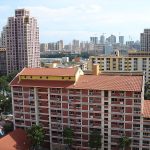The strong recovery of the Singapore private residential market and the private residential price growth has taken many by surprise, noted a research report by Savills Singapore. It noted that to market observers, this recovery seems surreal because, unlike the previous market recovery in 2010 (post Global Financial Crisis), where the local economy rebounded by a strong 15.2% and the URA Property Price Index responded with only a 17.6% YoY increase, this time, even if we see the 2018 economic growth rate hit 4.5%, well above market consensus, it will pale in contrast to the previous recovery. Yet private residential price growth in Q1/2018 have already risen 3.9% QoQ or an annualized rate of 16.5%.

The research asked a very searching question: “So what is driving this sharp price recovery?”, before venturing to answer its own question on private residential price growth.
Table of Contents
“To begin, we need to do some mental housecleaning. While it appears logical to associate GDP growth with most business sectors, for private residential properties, it can also turn out to be an archaic correlation. Visits to show flats leave a discerning observer with the impression that an increasing number of buyers at new launches are funded in part by their parents’ i.e. baby boomers’ money. This new engine of funding turns the economic correlation from a contemporaneous and/or forward-looking one to a multi-year, back-facing specification.
Moving forward, until the day our ageing demography can no longer influence the market, housing demand may not necessarily be driven by traditional variables like interest rates, demographics and future economic
performances.Rather, historical GDP growth rates will increasingly play a part. On top of that, theoretical investment function variables like interest rates, may, within bounds, lose their significance. The rear view mirror reflection of GDP represents the level of savings by the baby boomers.
Therefore, unless we expand our frame of reference to include the past, we will continue to misread the market by ignoring the savings level of the population of potential buyers.
Now savings is savings; what then is encouraging people to buy and developers to invest? A simple ratio cuts the long story short:
Future Launch Value of Private Residential Properties
Current Value of Private Residential PropertiesThe ratio for Singapore real estate is a modifiation of what in economics is called Tobin’s q. This ratio had been shown in economic research to exhibit a positive correlation to the level of investment. In other words, when the future market value of the physical asset (the numerator) is greater than its replacement cost, the impetus is for both individuals and companies to invest.
Although we have not conducted any empirical testing to confirm this for the private residential market, it conforms to what our marketing specialists are witnessing on the ground. The concept of a Tobin’s q for private residential properties is also clearly illustrated in the collective sales market when the ratio can be modified to:
Future Sales Price of All Units on the Collective Sales Site less Construction Cost
Current Value of Existing Units on the Collective Sales SiteA ratio >> 1 (>> means much greater) would start to whet the interest of some subsidiary proprietors to initiate a collective sale. This modified Tobin’s q is actually what collective sale specialists have been using to identify developments or pitch for appointments without knowing it.”
Savills Singapore said that fthey have touched on two alternative insights into the local private residential market, namely, the need to look at GDP backwards, and the ratio that encourages or discourages private residential investment. Without extending this field of analysis to other factors, by focusing on these two alone, they almost deciphered what the market outlook will be for the next twelve months.
“In the next few years, expect economic growth to be subdued compared to a decade ago while concerns about the ageing population increase. The manifestation of these issues may, however, for the medium term, be subjugated by the copious savings built up through the decades of high economic growth by the upper deciles of the households.
“This, together with the ingrained expectation for price appreciation, built up over many years of witnessing private property prices increase to record levels, are likely to goad those with the wherewithal to invest in real estate. The same goes for real estate developers whose balance sheets have become stronger over the decades and whose view of the long-term price appreciation of house prices gives them confidence to reinvest their capital.
“On the strength of Q1/2018’s strong 3.9% QoQ price increase, we are revising our forecast for 2018’s private residential price growth from 12%-15% to 15%-20%.”
Paul Ho, chief mortgage consultant at icompareloan.com, commenting on the recent private residential price growth said that the growth is only in certain segments. Even the luxury segment is split into two portions (the luxury segment and the super luxury segment), he explained.
“The luxury segment is actually quite wide, generally any properties pricing above $2,000 per square feet would fall into this classification. In a vague sense, landed properties also fall under luxury segment if we classify them based on housing type,” Mr Ho said.
He added: “if we based luxury segment based on district, I will go for properties that are more than 10 years old, well maintained and selling at below $1800 per square feet for size segment of around 800 square feet to 1200 square feet. The price quantum is acceptable while there may be potential upside if the prices start to move up.”
“All these will ultimately have an impact on home prices and the private residential price growth in Singapore.”
If you are an HDB flat owner and want in on the action of the private residential price growth in Singapore, there is a possibility that you may be able to sell your HDB to buy 2 condos. Our Panel of Property agents and the mortgage consultants at icompareloan.com can help you now.
Our affordability assessment and best home loans will put your heat at ease and the services of our mortgage loan experts are free. Our analysis will give best home loan seekers better ease of mind on interest rate volatility and repayments.
Just email our chief mortgage consultant, Paul Ho, with your name, email and phone number at paul@icompareloan.com for a free assessment.






